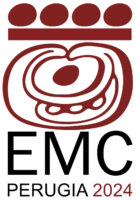29th European Maya Conference: Perugia, Italy
“Colour in Mesoamerica”

The 29th Annual European Maya Conference is organised by Wayeb – the European Association of Mayanists – in cooperation with the Centro Studi Americanistici “Circolo Amerindiano” – in Perugia, Italy. The conference will begin with an introductory lecture on Monday 7th October, followed by three-and-a-half-days of workshops (8th–11th October), with an afternoon off (with extracurricular activities planned, to be announced) on Friday 11th October, and concluding with a two-day symposium held from Saturday 12th October to Sunday 13th October 2024, in the Sala dei Notari at Palazzo dei Priori in Perugia.
The theme for the 29th European Maya Conference is COLOUR IN MESOAMERICA. The topic will be explored from a variety of perspectives, taking into account the time-depth and cultural and geographic expanse of Mesoamerica.
During this conference, we will explore questions concerning the use and perception of colour in Mesoamerica, including, but not limited to:
- What were (and are) the sources for different colours in Mesoamerica?
- What colours were used to paint buildings and monuments, and were all of them painted in the past?
- How do we know what colours looked like during pre-Hispanic times?
- What, if any, has been the impact of the limited survival of colour in a variety of contexts across Mesoamerica on contemporary perceptions of the past?
- How was (and is) colour perceived and represented in the art and writing systems in different eras from pre-Hispanic to modern times?
- Have there been any discrepancies in perceptions of colour between indigenous groups, between indigenous groups and colonisers, or between indigenous groups and non-local scholars over time?
- What kind of colour terminology do Mesoamerican languages use and why?
- What kind of potential symbolic meanings do different colours hold and how, if at all, have these changed over time?
The theme of the conference will be approached from various disciplinary points of view – including (but not restricted to) anthropology, archaeology, biology, chemistry, epigraphy, history, iconography, linguistics, and psychology – as well as interdisciplinary approaches exploring the intersection of these disciplinary perspectives.
List of Speakers:
- Beata Anton: “Feathers as a Source of Colour in the Classic Maya Culture”
- David Buti, Davide Domenici, Joanne Dyer, Chiara Grazia & Danny Zborover: “Unveiling the Materiality of Codex Tonindeye: Palette and Painting Process of a Mesoamerican Painted Manuscript”
- Gaia Carosi: “The Colours of Cartography in New Spain”
- John Chuchiak: “Sacred Hues: Exploring the Role of Color in Late Postclassic and Colonial Yucatec Maya Religion and Effigy Censer Imagery”
- Albert Davletshin: “Reconstructing Proto-Tepehua-Totonacan Basic Colour Terms”
- Davide Domenici: “Twenty Years of Non-invasive Analyses of Mesoamerican Codices: Results and Open Problems”
- Élodie Dupey García: “Polychromy in Nahua Art: An Exploration from Indigenous Categories and Aesthetics”
- Cristina Gonzalez-Esteban & James Bacon: “Overcoming the Challenges of Whitewashing: Using 3D Source-Based Reconstructions to Present the Multiple Possibilities the Vibrant Maya Past Had to Give”
- Christophe Helmke: “Colors and Cosmology in Script and Image: A Vantage from Central Mexico”
- Mónica Itzel Sosa Ruiz: “No-Color, the Process to Obtain the Black and White on Ceramics with Negative Effect, in Michoacán, Clues for the Symbolic Interpretation of the Decoration”
- Harri Kettunen: “On Chromatology: A Mesoamerican Perspective”
- Carlos López Puértolas: “Chromatic Encounters at El Tajín (Veracruz, México): A Comparison Between Maya and Gulf Coast Color Technology During the Epiclassic (ca. AD 700-1100)”
- Catherine Nuckols: “In Living Color: Personified Color Terms in Late Classic Maya Inscriptions”
- Walter Paz Joj: “Los colores de ayer y hoy: La incorporación de la colorización digital en el arte maya contemporáneo” (online)
- Marie Ramelet: “Materiales coloreados, materiales entrelazados: Tejer la historia del complejo Color rojo / Objeto textil en el área maya”
- Sergio Romero: “Color, Affect and Discourse in Highland Mayan Languages” (cancelled)
- Daniel Salazar Lama & Ana García Barrios: “Dark Caves Beneath a Bright Sky: Visual Perception and the Use of Colour in the Calakmul Substructure IIC”
- Gabriela Saldaña: “Color in Context: The Polychromatic Stucco of Lamanai, Belize” (cancelled)
- Sanja Savkic Sebek: “Exploring the Expressive Potential of Colours in Mesoamerican Art”
- Jan Szymański & Julia Przedwojewska-Szymańska: “Remembering the Code: Continuity and Change of Colourful Altar Overlays in Modern Ritual Performances of Southeastern Mesoamerica”
- Ma. Luisa Vázquez de Ágredos Pascual & Cristina Vidal Lorenzo: “Remembering the Ancestors: Pre-Hispanic Colors in Colonial Houses of Chajul, Guatemala”
